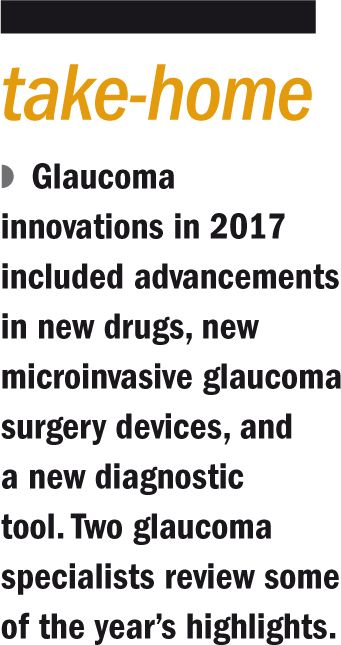Article
Drug, device innovations making strides for glaucoma care in 2017
Glaucoma innovations in 2017 included advancements in new drugs, new microinvasive glaucoma surgery devices, and a new diagnostic tool. Two glaucoma specialists review some of the year’s highlights.
By Laird Harrison; Reviewed by Andrew Iwach, MD, and Joel S. Schuman, MD

Advancements in new drugs, new microinvasive glaucoma surgery (MIGS) devices, and a new diagnostic tool made 2017 a banner year for glaucoma innovation.
On the pharmaceutical front, the FDA last month gave a green light to latanoprostene bunod ophthalmic solution 0.024% (Vyzulta, formerly Vesneo; Bausch + Lomb/Nicox).
“It’s always exciting to have another alternative available to us,” said Andrew Iwach, MD, executive director, Glaucoma Center of San Francisco.
Latanoprostene bunod works by a dual mechanism of action. It is metabolized in the eye to latanoprost acid and butanediol mononitrate.
An F2-alpha prostaglandin analog, latanoprost acid increases outflow of aqueous fluid primarily through the uveoscleral pathway. Butanediol mononitrate releases nitric oxide, which is reported to induce relaxation of cells in the trabecular meshwork and Schlemm’s canal, increasing outflow through them.
In the phase II VOYAGER study, IOP fell below 18 mm Hg in 68.7% of patients taking latanoprostene bunod 0.024% compared with 47.5% of patients taking latanoprost 0.005%.
It remains to be seen which patients will benefit most from latanoprostene bunod, said Joel S. Schuman, MD, chairman, Department of Ophthalmology, NYU Langone Medical Center, New York.

Glaucoma patients who have had Schlemm’s canal surgery without adequate pressure reduction might be good candidates, he surmised.
Netarsudil ophthalmic solution (Rhopressa, Aerie Pharmaceuticals) also took a step forward when an FDA committee recommended its approval.
“As I read the report, it was one of the most positive reports issued, so hopefully early next year we will get a new option,” Dr. Iwach said.
Netarsudil works by different mechanisms from drugs currently on the market. According to Aerie, the drug inhibits both Rho-kinase (ROCK) and noreprinephrine transporters (NET). Inhibiting ROCK relaxes the trabecular meshwork cells, while inhibiting NET reduces production of aqueous fluid.
“From the perspective of absolute IOP reduction, it seems to work just as well in people with IOP of 20 mm Hg or lower as those with high IOP,” Dr. Schuman said. “We’re excited about having this new class of drug.”
An evolution in the healthcare system also brought changes to glaucoma drugs in 2017.
“It’s a curious time in the world of generics,” Dr. Iwach said. “The prices of generics have increased, and something I have seen for the first time is that one of my patients asked me to prescribe a branded drug instead of a generic.”
The patient’s employer had recommended that the patient purchase the drug through a Canadian pharmacy because it was less expensive than buying a generic in the United States. Dr. Iwach has seen reports of similar arrangements between businesses and pharmaceutical companies to encourage purchasing branded drugs.
“We need to understand the implications of this as it further evolves,” Dr. Iwach said.

Diagnostics
Glaucoma patients in the United States also gained a diagnostic tool with the FDA approval of an IOP self-monitoring device (Icare HOME tonometer, Icare USA). The device, which has been available in Europe since 2014, is designed for use by patients. It performs automatic OD/OS recognition, uses green and red lights as guidance for positioning, requires no drops, and involves no puff of air.
The device allows patients to monitor their IOP throughout the day and could make physicians aware of any dangerous spikes, according to the company.
It is not yet clear how well patients can use the device, or what use clinicians can make of the data it provides, Dr. Iwach said.
“One of the questions is going to be when is the data going to affect what we do, especially if it requires an active step from the patient.”
Implandata’s Eyemate, by contrast, is implanted in the eye, allowing passive monitoring of IOP. In May, the device received CE Mark approval and is available for commercial use within Europe. That type of monitoring “may be appropriate, but we have to determine when it’s appropriate,” Dr. Iwach said.
Surgery
Though no significant new devices or procedures were approved in the United States in 2017, two MIGS devices that were cleared by the FDA in 2016 reached the U.S. market (CyPass Micro-Stent, Alcon Laboratories; XEN Glaucoma Treatment System, Allergan). The two devices offer an alternative to the trabecular micro-bypass stent (iStent, Glaukos).
Each of the devices opens up passages for drainage of aqueous fluid. The CyPass acts as a conduit between the anterior chamber and the supraciliary space. The XEN, composed of gelatin, is implanted through the sclera and connects the anterior chamber to the subconjunctival space.
By contrast, the iStent bypasses the inner wall of Schlemm’s canal and allows aqueous humor more direct access from the anterior chamber to the collector channels at the outer aspect of Schlemm’s canal.
Other MIGS devices are also working through trials, and this approach seems to have opened the flow of change in glaucoma surgery.
Andrew Iwach, MD
e: ai@glaucomasf.com
Dr. Iwach disclosed financial interests in Alcon Laboratories and Bausch + Lomb.
Joel S. Schuman, MD
e: joel.schuman@nyumc.org
Dr. Schuman disclosed financial relationships with Aerie Pharmaceuticals,
Alcon Laboratories, Annexon, Elsevier, lOP Medical, Ocugenix, Opticent Health,
Pfizer, Shire Pharmaceuticals, Slack Inc./Vindico Medical Education, and
Zeiss Optical.
Newsletter
Don’t miss out—get Ophthalmology Times updates on the latest clinical advancements and expert interviews, straight to your inbox.




